QBARS - v29n4 New Discoveries of Rhododendrons in Japan
New Discoveries of Rhododendrons in Japan
Hideo Suzuki, Kumagaya, Japan
From a paper given at the 1975 Annual Meeting in Bellevue, Washington
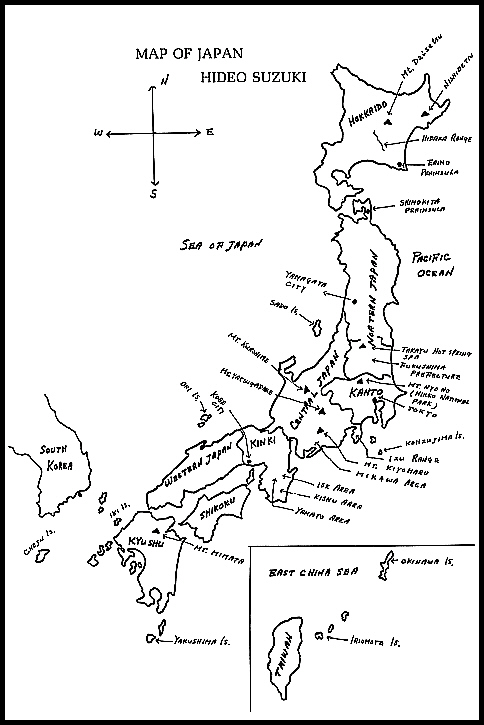
|
We Japanese hobbyists have recently discovered quite a number of new forms, some of which may be recognized as species or varieties in the future, and also we have found some lost ones again, I, myself, for the past several years have made extensive trips throughout the Japanese archipelago searching for something new, contacting many local hobbyists to obtain information in their localities and exploring many wild areas.
The following are some of the newly discovered forms:
Three-leaved azalea, dwarf form on the Island of Yakushima.
In the Western World,
R. reticulatum
seems to be a synonym for three-leaved azaleas and, if my knowledge is correct, many of these azaleas seem to be simply called
R. reticulatum
. As a matter of fact, the famous book "The Species of Rhododendron" includes several three-leaved azalea species, such as
R. wadanum
,
R. nudipes
,
R. logopus
, etc., in
R. reticulatum
.
In Japan, however, our taxonomists classify our indigenous three-leaved azaleas into as many as twenty-seven different species and varieties. In addition, there have been found a great many new forms. A controversy is developing in my country whether or not savants should have classified them into so many species and varieties.
For us amateurs, however, this certainly provides great entertainment in which we are driven to collect as many different ones as possible. Although most of them are not in general cultivation in Japan, three-leaved azaleas are the target of many of our enthusiastic collectors of rhododendron. They are floriferous, many of them bloom before the leaves and there are many species and varieties. All of these facts combined seem to intrigue our rhododendron hobbyists.
A friend of mine, who induced me to get into this hobby, was lured into becoming a rhododendron hobbyists by a single plant. He lived in a residential area in Tokyo and was strolling in his neighborhood on a warm spring day when he suddenly noticed in the front yard of a house, a beautiful free-flowering tree with no leaves that he had never seen before.
Although he had been a long-time hobbyist of such fancy plants as camellias, roses and orchids, he was so fascinated by the unknown plant that he knocked at the door of that house to find out what it was. He was told that the plant was R. wadanum , a member of the three-leaved azaleas that usually grew at high elevations in the nearby mountains. Thus, his chase after three-leaved azaleas began.
I donated to the Seed Exchange the seed of R. wadanum this year. On the list Mrs. Berry added the word, reticulatum , with brackets after the name R. wadanum . She was certainly right and correct since the book "The Species of Rhododendron" defines R. wadanum as synonymous with R. reticulatum. However, R. wadanum is actually quite different from R. reticulatum on several points. The biggest difference is that while R. wadanum blooms before the leaves, R. reticulatum flowers with the new leaves or after the leaves. I believe R. wadanum is by far more beautiful than R. reticulatum. As for R. nudipes , it is pure pink in flower and is prettier than R. reticulatum.
On the island of Yakushima, the home of R. yakushimanum , there grows a three-leaved azalea which is usually regarded as R. nudipes although, from its appearance, I personally doubt the name. This species on Yakushima Island is erect in habit and grows as tall as six feet.
Very recently, however, an extremely dwarf form of a three-leaved azalea has been discovered an the island. It is a very low-growing bush, being usually three to five inches high and having leaves as tiny as a third or a fourth the size of the leaves of the aforementioned large species. It is interesting to note that this miniature three-leaved azalea coexists side by side at high elevations with the large sized one. Also it is possible to classify this dwarf into two forms, a tiny form and a tinier form.
We believe it is an entirely different species from the large one because in its habitat on the island, most of the foliage of the midget is lost, apparently eaten by some form of wildlife, probably the deer that roam about. On the other hand, the foliage of the large species is left not eaten at all in spite of the coexistence of the two. Also it is highly interesting that this pigmy grows only on the ridge where the dwarf R. keiskei 'Yaku Fairy' is found.
Just two or three years ago another three-leaved azalea was found in the Hidaka mountain range in our northernmost island, Hokkaido. Until then, this form had not been reported. It may be a new species, although to me it looks like an isolated distribution of R. wadanum which grows mostly in the Kanto Area, south of Northern Japan.
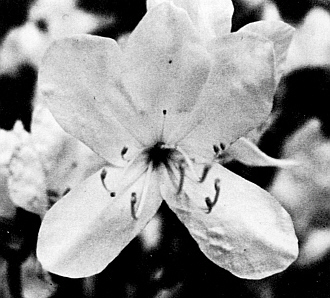
|
|
Fig. 44:
R. wadanum album
Photo by Hideo Suzuki |
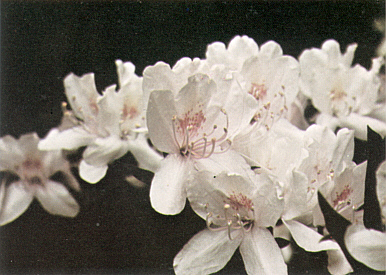
|
|
R. tashiroi
Photo by Hideo Suzuki |
R. tashiroi
, bristly form
.
R. tashiroi
grows in Kyushu, Yakushima Island and Shikoku, where it has only recently been discovered growing. In a limited area in Kyushu, however, a different form called 'bristly tashiroi' grows. The leaves have conspicuous hairs and the flower is pinkish blue. It is rare and is much more beautiful than the type form.
R. niko-montanum
This is the species I always find in the want-list of seeds from overseas. Nevertheless, it is rare in the wild and not in cultivation in Japan.
It was originally discovered on Mt. Nyohoh in Nikko National Park and named by Dr. Nakai. Nikko is the place every tourist from abroad should avoid missing. We have an old saying: "You should not say you are happy without seeing Nikko.
" For quite some time no report had been heard of the plant from Mt. Nyohoh. From the first, it was one of our most controversial rhododendrons. Dr. Nakai mentioned that it was considered to be a natural cross in the wild between R. brachycarpum and R. chrysanthum .
One of the controversies is whether there is the possibility for a natural cross between these two rhododendrons occurring on Mt. Nyohoh where the flowering time of the two species differs by a month or so. Also, it is not known clearly what the true R. niko-montanum is. The definition says it is erect in habit and the leaves are smaller than R. brachycarpum and the flower is yellow in color.
In a 1968 expedition to Mt. Nyohoh, many pictures of the would-be R. niko-montanum were taken at its flowering time. If it is really the cross between R. brachycarpum and R. chrysanthum , we believe the flower should be flushed pink at least on the base of the filaments, on the throat of the corolla or on the bud's tip. If it has blotches, they should be brown or pink and not green or yellow. If our method of identification is correct, one of my color slides shows the true plant.
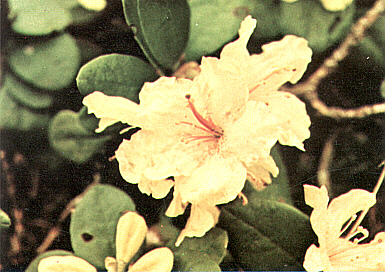
|
|
R. niko-montanum
Photo by Hideo Suzuki |
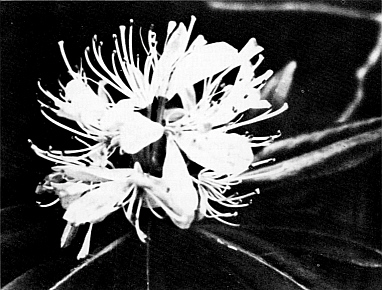
|
|
FIG. 45
R. degronianum
f.
polypetala
Photo by Hideo Suzuki |
R. degronianum
f.
polypetala
The corolla is polypetalous. All the petals are cut to the calyx. The truss looks like angels dancing and is of elegant beauty.
This 'Dancing Angels' was discovered in the wild in Yamagata Prefecture, Northern Japan. My friend was so fascinated by the plant that he would visit the owner every year at its flowering time, traveling all the way from Tokyo. In Japan, this sort of plant is priceless.
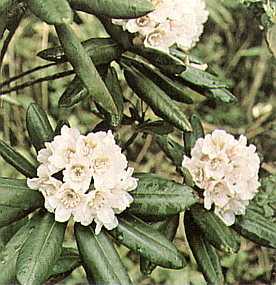
|
|
R. brachycarpum
f.
nemotoanum
Photo by Hideo Suzuki |
R. brachycarpum f. nemotoanum
In the corolla the stamens are incompletely but regularly petalized. It seems to be of ornamental value. Over sixty years ago, this plant was first discovered in the wild at a high elevation near Takayu Hot Spring spa, Northern Japan, by a young student of botany. The plant was named
R. brachycarpum
f.
nemotoanum
in honor of his teacher, Dr. Nemoto and later designated as the flower of Fukushima Prefecture, which includes its habitat.
Despite this fact, it soon disappeared in the wild, leaving no trace at all. After that, even the prefectural residents had not actually seen the flowers for decades, so they called it the "Phantom Plant.
"Similar plants were found in some other places in Northern Japan but they were all poor forms with only some of the stamens petaloid or, in better cases, with only a few trusses being like the nemotoanum form and all others like the standard type. As I obtained information on this plant from various sources, I became more and more confident that it still existed at the place where it had originally been found. I was encouraged enough to make an attempt to find this 'Phantom Plant' again.
Then, last spring, the Northern Japan Chapter of the Japanese Rhododendron Society planned their meeting at Takayu Hot Springs spa near where the nemotoanum form was discovered some sixty years ago. I attended the meeting, of course. Among the participants there were those who came from the vicinity, but they all admitted that they had never seen the plant.
To make a long story short, I finally met the proprietor of a hot spring inn at Takayu who was a long-time alpinist and knew every place in the nearby mountains. He was affectionately called "Uncle Beard" by other younger alpinists who often put up at his inn. He eventually confessed he was the one who had made a 'phantom' of the plant in order to protect it from plant thieves. Year after year he used to pick all the flowers off as soon as they bloomed.
After an hour's persuasion, he agreed to take me to the spot when the plant was in bloom in the middle of July. I ascended to the place on a rainy July day when our rainy season was in full swing. I was luckily able to confirm five of the plants buried among thousands of standard R. brachycarpum . I took a few pictures, then the roll of film in my camera was used up.
Soaked in rain, I hurriedly reloaded my camera and took many pictures, forgetting everything else. I was so excited about coming across the phantom flowers that I must have made a mistake loading the camera. Later I found that the film had not advanced as I took pictures. I was awfully disappointed, but there was no use crying over spilt milk. Thus, the few pictures I took at first became the precious ones.
I didn't consider collecting seed for the Seed Exchange nor did I even think about picking the seed although there were some seed capsules left, evidently from the few flowers "Uncle Beard" failed to pick off. Why? Because the probability of the seed coming true would be 100,000 to 1, or less. Under the circumstances in which the "Phantom Flower" was found, the chances of its C. W. seed coming true is much worse than its O. P. seed collected in a garden. It wouldn't be worth 25 cents a packet, much less a $1.00 a packet from the Seed Exchange.
